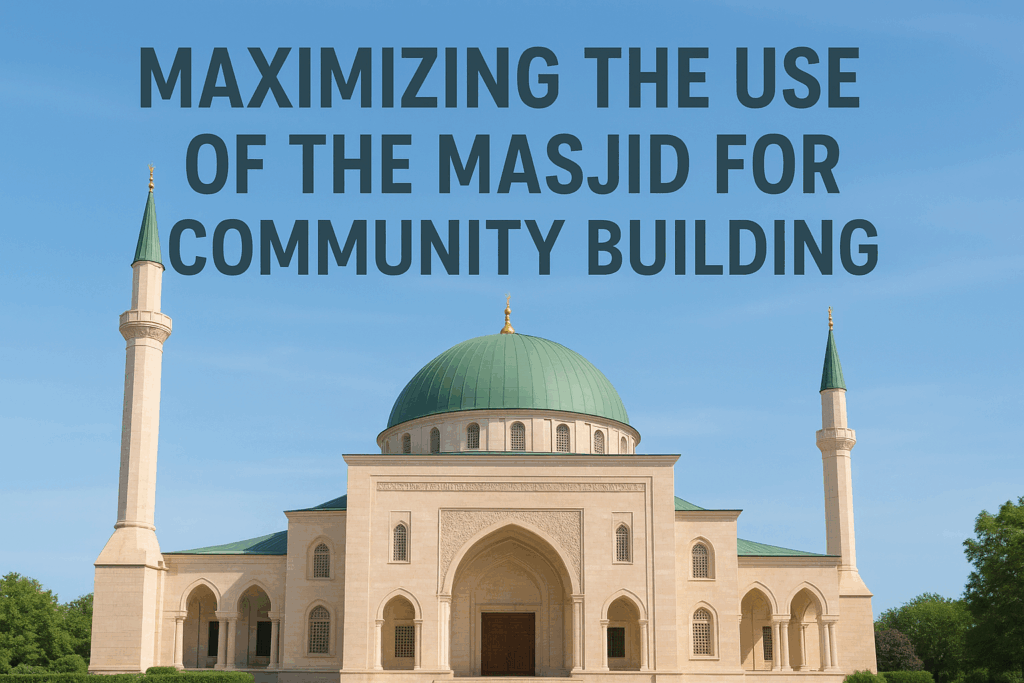Community, Islamic Principles
Maximizing the Use of the Masjid for Community Building
The masjid (mosque) occupies a central place in Islam: it is a house of worship, a school, a meeting-place, and historically it has been the heart of Muslim civic life. Yet many today think of the masjid only as a place for ritual prayer and overlook its vast potential as a hub for community welfare, education, and mutual support. This article explains the Islamic foundations for a broader communal role for the masjid, then offers practical, faith-based ways to expand and maximize that role so the masjid becomes a living engine of community building.
Islamic Foundations: Scripture and Prophetic Guidance
The Qur’an and authentic hadiths make clear that masājid (mosques) are sacred spaces entrusted to the believers and deserve care, but they are also meant to serve the community. First, Allah reminds believers that the masjid is His house and must be preserved and honored: “The mosques of Allah shall be maintained only by those who believe in Allah and the Last Day, perform As-Salaah, and give Zakāh and fear none but Allah. It is they who are on true guidance” [Al-Tawbah :18]. The Qur’an also warns against associating partners with Allah, noting: “And the mosques are for Allah, so do not invoke with Allah anyone” [Al-Jinn:18]. This verse underscores the spiritual centrality of the masjid while implying its purpose, remembrance of Allah and communal devotion, not private gain or idolatrous practices.
The Prophet ﷺ affirmed the reward and sanctity of building and caring for masājid. He taught that contributing to a mosque earns immense reward: “Whoever builds a mosque, Allah will build for him something like it in Paradise” [Al-Bukhaari (450), Muslim (533)]. This hadith highlights the enduring spiritual value of establishing and maintaining communal worship spaces.
These texts together form an Islamic mandate: masājid belong to God, are to be maintained by the believing community, and are worthy of investment. From that mandate flows the permissibility, and the moral duty of using mosques for the spiritual and social welfare of the community.
A theological case for community services in the masjid
- Masājid as centers of ʿibādah (worship) and ʿamal (action): Worship in Islam is holistic. Acts of worship that strengthen the community, including teaching, feeding the poor, advising the troubled, are extensions of worship. Serving people through the masjid is therefore an expression of devotion, in line with verses that link belief, prayer, and zakāh to maintaining the mosques.
- Charitable continuity: Building schools, clinics, or programs at the mosque creates lasting benefit (Sadaqah jāriyah). The hadith about building a mosque promising a house in Paradise illustrates that physical institutions that serve people carry ongoing reward.
- Prophetic precedent: The Prophet’s Mosque in Madinah served as a court, school, medical center, and civic hall. The Prophet ﷺ met delegations, taught students, cared for the sick, and settled disputes there. Following that example, today’s masājid are natural places for communal functions beyond ritual prayer.
Practical ways to maximize the masjid for community building
- Education and lifelong learning: Regular classes, skill-building workshops, study circles and mentoring.
- Social services and welfare: Zakat and Sadaqah distribution, food pantry, emergency support fund.
- Counseling and family support: Marriage counseling, mental health partnerships.
- Youth engagement and leadership: After-school programs, sports and recreational activities, youth councils/volunteer corps.
- Women’s programs and inclusion: Women-led educational circles, childcare during khutbahs and events to enable participation.
- Health, legal, and civic services: Health clinics and screenings, legal aid and civic engagement drives.
- Civic outreach: Open houses, community resource fairs.
- Governance, transparency, and volunteer systems: Clear governance & accountability, volunteer management system and feedback mechanisms.
Practical steps to start (a roadmap)
- Community needs assessment: simple surveys and listening sessions to identify top needs (food insecurity, youth programs, language barriers).
- Pilot programs: start small (one weekly food distribution, one evening class) and evaluate.
- Partner locally: hospitals, legal clinics, schools, and nonprofits can provide expertise and share costs.
- Train volunteers: give basic training in safeguarding, confidentiality, and cultural sensitivity.
- Sustainability plan: diversify funding, sadāqah, endowments (waqf), grants, and fundraising events.
- Publicize impact: Annual reports, community stories, and measured outcomes to build trust and attract support.
In conclusion, the masjid was not intended to be a narrow, single-purpose building. Scripture and Sunnah call believers to keep the house of Allah in a manner that serves faith and community. Maintain the masjid, teach in it, support those in need, and use it as a base for righteous action. The Qur’anic instruction that the mosques are tended by the righteous (9:18) and the Prophet’s promise about building mosques for Allah (reward in the Hereafter) should inspire every community to envision the masjid as both a sanctuary of worship and a home of service.
May our masājid be places where hearts are softened, knowledge is spread, burdens are eased, and communities are strengthened. Ameen.

